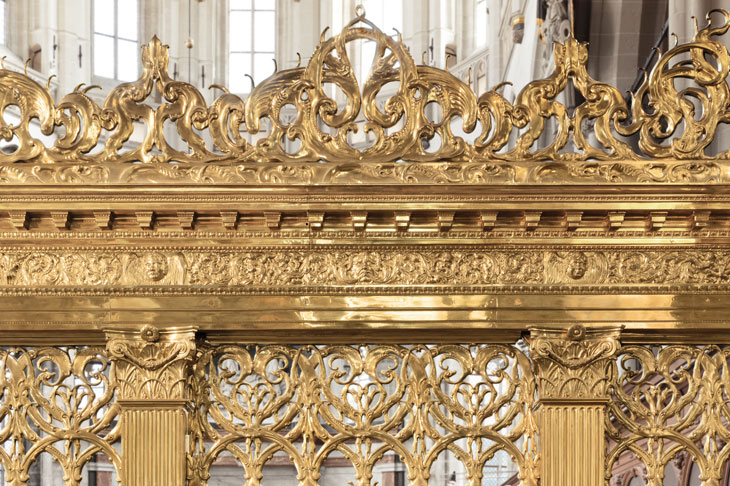The auricular style – or kwab as it is termed in Dutch – is well represented at the Rijksmuseum. We are privileged to have in our collection many of the principal masterpieces by the three great Dutch goldsmiths – Paulus and Adam van Vianen and Johannes Lutma – who were the main inventors of this ornamental language. Their astonishing cups and dishes are prominently displayed in the 17th-century galleries on the museum’s main floor, where they command considerable attention. But we felt that they should for once be joined by their peers from elsewhere, in an exhibition devoted to kwab, as the unique place within Dutch 17th-century culture of this mysterious phenomenon is insufficiently realised or appreciated.
The words kwab (lobe) and auricular, current since the 19th century, describe elements of the objects’ physical appearance, in particular their resemblance to parts of the human body. In the 17th century the terms ‘grotesques’ and ‘snakerijen’ (pranks or caprices) were used. Although these are rather general, they do draw attention to kwab’s origin in the bizarre inventions of the 16th century and to its fanciful, fantastic nature.
Lidded ewer (1614), Adam van Vianen. Rijksmuseum, Amsterdam
No object better illustrates the essence of kwab than a silver ewer made by Adam van Vianen in 1614. It seems to be in movement: its abstract, ill-defined forms appear to turn into masks, monsters or bodies. Kwab cannot be categorised as applied ornament, but constitutes the very substance out of which this piece is fashioned. The silversmiths’ guild of Amsterdam commissioned it from Adam van Vianen to commemorate his brother Paulus, who had died the previous year in Prague, where he had been Emperor Rudolf II’s favourite court goldsmith. This unprecedented commission demonstrates that the van Vianen brothers were regarded not just as the greatest goldsmiths of their time, but as artists in a class of their own. During the years of research and reflection leading up to the exhibition, I have come to realise that this extraordinary esteem was largely based on their mastery of kwab, which was admired as a new art form.
Paulus van Vianen created the earliest pure kwab forms on a small scale, in precious works of silver and gold made for the delectation of the emperor and a select circle of cultured courtiers. Adam’s ewer was commissioned by a semi-public organisation, where it must have been easily accessible. It instantly became the most celebrated work of art in Amsterdam. It was portrayed countless times by painters such as Pieter Lastman and Gerbrand van den Eeckhout, incorporated into scenes from the Bible, ancient history and mythology; some of these paintings will be shown next to it. I know of no comparable phenomenon in the history of the decorative arts of Europe.
Design for a condiment dish (c. 1640–50), attributed to Johannes Lutma. Rijksmuseum, Amsterdam
Artists and critics were dumbfounded by the originality of the ewer. It was obviously created ‘from the mind’ rather than ‘from nature’ – a vital distinction at the time. How did van Vianen create such a piece? He probably used models in wax, none of which are known to survive, and certainly made drawings. In order to probe the imaginative process underlying the creation of these works of art, the small body of auricular drawings firmly attributed to the van Vianens and Johannes Lutma will be assembled. Here the Rijksmuseum is not so fortunate, and for this section we depend on generous loans from Stockholm, New York, Vienna and London. Happily, during the preparation of the show I came across a previously unknown design, almost certainly by Lutma, which the Rijksmuseum has been able to acquire through a gift from H.B. van der Ven.
With Lutma, kwab was developed to the full. He produced moulds for gilt leather hangings – since the Museum De Lakenhal in Leiden is currently undergoing rebuilding work, we are able to show spectacular hangings from 1649 which are normally displayed on the walls of a panelled room there. Moreover, he was asked to design the stupendous brass choir-screen in Amsterdam’s Nieuwe Kerk, an auricular reinterpretation on a massive scale of gothic precursors. Though it would seem impossible to miss, it is often all but overlooked by visitors to the exhibitions that take place in the church building. For the first time ever, two magnificent doors from this screen are being lent to the exhibition.
Part of a brass choir screen at De Nieuwe Kerke, Amsterdam, cast by unknown brass-founders in c. 1654, after a design by Johannes Lutma, probably in collaboration with Jacob van Campen. Courtesy Rijksmuseum, Amsterdam
That Lutma’s friend and admirer Rembrandt created kwab works of art and actively stimulated its flowering into a form of early baroque is not generally acknowledged. A vital part of the exhibition will be devoted to Rembrandt’s role as the ‘Bernini of Amsterdam’, focusing on his painting The Holy Family with a Curtain (1646), on loan from Kassel, with its magnificent trompe l’oeil painted auricular frame.
Dutch kwab grew out of international mannerism, and it influenced, or was paralleled by, similar movements all over northern Europe. With spectacular pieces such as the London silver basin by Christiaen van Vianen, Adam’s son, from the Victoria and Albert Museum, paintings in auricular frames from Ham House in Richmond, a Parisian cabinet from Stockholm, and a huge retable by Hans Gudewerdt the Younger from Eckernförde, the exhibition will stimulate international comparisons. Above all, I hope it will underpin the unique status of Dutch kwab – admired in its time even more than ‘Dutch design’ is by many today.
‘KWAB: Dutch Design in the Age of Rembrandt’ is at the Rijksmuseum, Amsterdam until 30 June–16 September.
From the June 2018 issue of Apollo. Preview and subscribe here.
